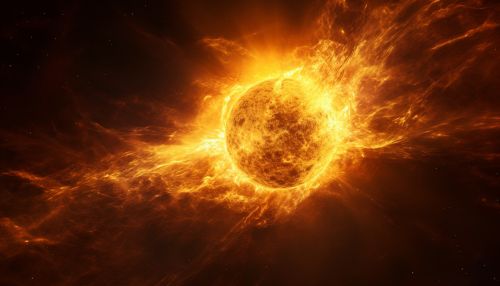Solar Wind
Introduction
The solar wind is a stream of charged particles released from the upper atmosphere of the sun. This plasma mainly consists of electrons, protons and alpha particles with kinetic energy between 0.1 and 1 keV. The composition of the solar wind plasma also includes a mixture of materials found in the solar plasma: trace amounts of heavy ions and atomic nuclei such as helium, oxygen, and neon. The solar wind varies in density, temperature, and speed over time and over solar longitude.
Origin
The solar wind is generated in the solar corona. The corona, the sun's outer atmosphere, is an extremely hot and tenuous plasma which is not bound by gravity and expands supersonically into interplanetary space. This flow of plasma is the solar wind. The temperature of the corona is so high that the sun's gravity cannot hold on to it. Although we understand why this happens, the details of the process are still not well understood.


Composition
The solar wind is a plasma, which means it is composed of charged particles. These particles are primarily protons and electrons, which make up about 99% of the solar wind. The remaining 1% is made up of heavier ions, such as helium ions, and trace amounts of even heavier ions such as oxygen and neon. These heavier ions are thought to be remnants of the material from which the sun itself formed.
Characteristics
The solar wind is not uniform. Although it is always directed away from the sun, it changes speed and carries with it magnetic clouds, interacting with the earth's magnetosphere, and can cause geomagnetic storms. The solar wind speed is high (about 800 km/s) over coronal holes and low (about 300 km/s) over streamers. These high and low speed streams interact with each other and alternately pass by the earth as the sun rotates.
Effects on Earth
The interaction of the solar wind with the Earth’s magnetosphere can produce a variety of effects. The most well-known is the aurora borealis, or northern lights, and its southern counterpart, the aurora australis. These are caused by solar wind particles interacting with the Earth's magnetic field and the atmosphere. The solar wind can also have more serious effects, such as causing damage to satellites and power grids during periods of high solar activity.
Solar Wind and Space Weather
The solar wind is a major component of space weather, which can affect not only the Earth, but also spacecraft and astronauts in space. Changes in the solar wind can cause changes in the Earth's magnetosphere and ionosphere, leading to disruptions in radio communications and GPS signals. Space weather is an important field of study, not only for understanding the sun and its effects on the Earth, but also for practical applications such as satellite design and space travel.
Solar Wind and Solar Sails
The concept of solar sails has been proposed as a method of propulsion for spacecraft. Solar sails work by capturing the momentum of the solar wind in a large, lightweight sail. The pressure exerted by the solar wind on the sail would provide a continuous source of propulsion, allowing a spacecraft to reach high speeds without the need for fuel.
